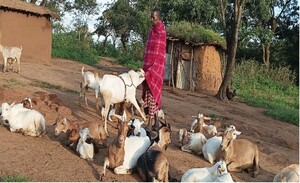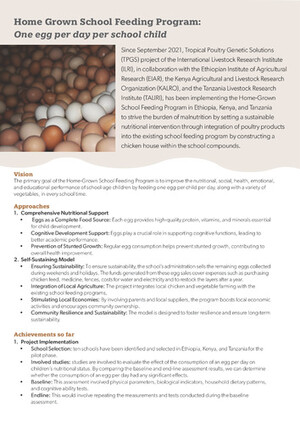
Estimates of genetic parameters and genetic trends for growth traits in Menz sheep under community-based breeding programs
Abstract
The main objectives of this study were to estimate genetic and phenotypic parameters for growth traits in Menz sheep under community-based breeding programs (CBBPs). Data used in the study were collected from five Menz CBBPs villages during 15-year period (2009 to 2023). Studied growth traits were birth weight (BW), weaning weight (WW), six-month weight (6 MW), yearling weight (YW), Average daily gain from birth to weaning (ADG1), average daily gain from weaning to six months (ADG2) and average daily gain from six months to yearling (ADG3). Fixed effects were estimated using the GLM procedure of SAS 9.4. Genetic parameters were estimated fitting different univariate animal models using Average Information Restricted Maximum Likelihood (AI-REML) procedure using WOMBAT software. The most appropriate model for each trait was determined applying likelihood ratio tests. Model including only direct additive genetic effect was the most appropriate model for BW, YW, ADG2 and ADG3, whereas model including direct additive and maternal additive genetic effect without taking into account covariance between them was the most appropriate for WW, 6 MW and ADG1. Based on the most appropriate models, direct heritability of BW, WW, 6 MW, YW, ADG1, ADG2 and ADG3 were 0.29 ± 0.01, 0.45 ± 0.01, 0.46 ± 0.02, 0.42 ± 0.02, 0.44 ± 0.01, 0.75 ± 0.02 and 0.21 ± 0.02, respectively. The estimated maternal heritability were 0.04 ± 0.01, 0.02 ± 0.01 and 0.02 ± 0.01 for WW, 6 MW and ADG1, respectively. Additive coefficient of variance were ranged from 9.53% for BW to 33.02% for ADG2. Moderate to higher estimates of direct heritability and additive coefficient of variation (CVA) in the current study indicates higher potential for genetic improvement of studied traits through direct selection. The genetic trends for WW, 6 MW, and YW showed a positive improvement a rate of 0.02, 0.038 and 0.03 kg over years, respectively. Optimizing the ongoing breeding program into specializing-sire producer groups and applying intensive selection on the sub-nucleus flock could improve the efficiency of the breeding program. Genetic correlations among the studied traits were ranged from -0.50 for ADG-ADG2 to 0.98 for WW-ADG1. Genetic correlation between 6 MW and other studied traits was positive and moderate in magnitude. To achieve optimum genetic gain, the implemented selection criteria for Menz sheep (6 MW) should be continued.
Citation
Besufkad, S., Goshme, S., Abebe, A., Bisrat, A., Abebe, A., Zewdie, T., Demis, C., Yitagesu, E., Aydefruhim, D., Tesema, Z., Gizaw, S., Getachew, T., Rischkowsky, B., Rekik, M., Belay, B., Wurzinger, M., Sölkner, J. and Haile, A. 2024. Estimates of genetic parameters and genetic trends for growth traits in Menz sheep under community-based breeding programs. Small Ruminant Research 241: 107384.










